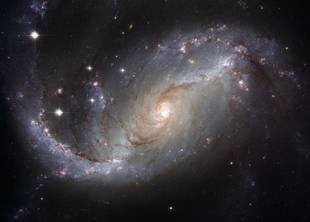
The term "black hole" was coined by American theoretical physicist John Archibald Wheeler in 1967 to describe this awesome cosmic phenomenon, but the concept of this supermassive body was first put forward by English geologist John Michell in 1784. Albert Einstein predicted its existence in his Theory of Gravity (General Relativity) in 1915.
Theoretically, a black hole forms when a massive star runs out of fuel. Without energy to support its mass, the star implodes. If the star is more than 25 times the mass of our sun, the core will collapse to a point of infinite density with no surface. Within a boundary of about 50 miles from the black hole center, gravity is so strong that not even light can escape its pull. This boundary is theoretically known as the event horizon.
Information on black holes is limited, though indeed numerous schools of theory exist. Scientists like Karl Schwarzschild, Jayant Narlikar and Stephen Hawking have built upon ideas from Einstein and others to offer theories on black holes. And yet, they still remain an enigma. Because extensive and proven black holes information is scarce, they remain a constant area of intrigue and curiosity.
Until recently, black holes have remained hidden beneath invisibility cloaks. Indeed, Whereas a lot has been known about the existence and properties of black holes from Einstein's theory of general relativity, tangible evidence has been a recent phenomenon.
According to astronomers, black holes have remained hidden beneath invisibility cloaks. Indeed. Whereas a lot has been known about the existence and properties of black holes from Einstein's theory of general relativity, tangible evidence has been a recent phenomenon.
According to astronomers, black holes exist in at least two different sizes. Stellar black holes, formed from the death and gravitational collapse of a massive star, is about ten to 20 times the mass of our sun. Dwarfing the stellar type, supermassive black holes hold millions to billions the mass of our Sun, and lurk at the centers of many galaxies.
Indirect evidence from X-ray telescopes has revealed telltale signs of thousands of black holes lurking in our own galaxy and beyond. Many are the remnants of exploded stars. But to other far more massive black holes, swallowing a single star is like a blue whale gulping a mosquito.
It is believed that super-massive black holes are located at the core of every galaxy. According to Suvi Gezari of the California Institute of Technology in Pasadena, the Milky Way galaxy in which our solar system resides has a dormant super-massive black hole at its center. They can have the mass of a trillion suns squeezed into an area the size of our solar system. Smaller stellar black holes can lurk throughout a galaxy. Middleweight black holes, discovered in 1999, range from the 100 to 10,000 suns in mass but are no bigger than our moon.
Over thousands of years, black holes grow bigger by consuming material whizzing around them. Just before gas and dust get sucked into a black hole, this matter heats up so much that it emits streams of x-rays. NASA's Chandra X-ray Observatory and other telescopes equipped with x-ray vision spot the distant lights.
That's how astronomers pinpointed the first black hole, called Cygnus X-1, in 1971. Since then, thousands of black holes have been spotted, bringing to light answers to many questions. In 2001, observations of Cygnus X-1, roughly 6,000 light-years away, provided the first glimpse of material actually falling into a black hole.

















